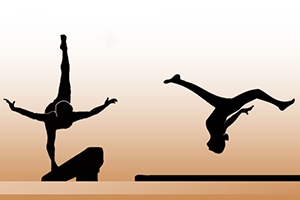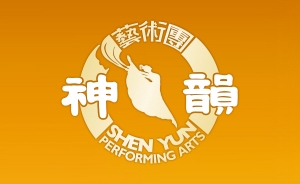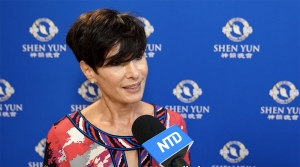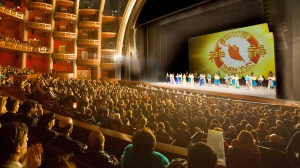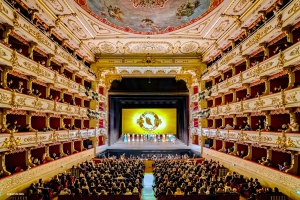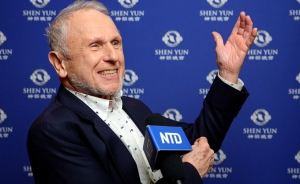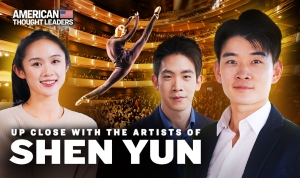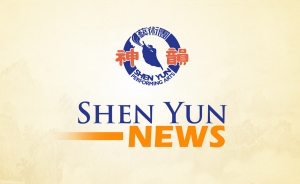
7 Sự Khác biệt giữa Múa cổ điển Trung Quốc và Múa Ballet
Như chúng ta đã biết, múa ballet là một bộ môn nghệ thuật cổ điển tao nhã, vở múa ballet “Kẹp hạt dẻ” và “Hồ thiên nga” cũng được yêu thích trên toàn thế giới. Tuy nhiên, những năm gần đây, có một loại hình nghệ thuật vũ đạo khác đang được nhận thức lại mới. Loại hình nghệ thuật vũ đạo này có một hệ thống đào tạo phong phú hoàn mỹ, đồng thời bao quát nội hàm văn hóa rộng lớn và lâu đời. Đây là một kho tàng văn hóa quý báu đã bị chôn vùi từ lâu. Trong thời đại nghệ thuật chính thống không được hoan nghênh, loại hình nghệ thuật vũ đạo này lại tỏa sáng rực rỡ phi thường, khi vừa xuất hiện trên sân khấu, lập tức thu hút sự quan tâm của những người yêu mến nghệ thuật trên toàn thế giới. Đó chính múa cổ điển Trung Quốc.
Múa cổ điển Trung Quốc chú trọng vào “thân vận”, “thân pháp” và “kỹ năng kỹ thuật”, vốn có năng lực biểu đạt vô cùng phong phú. Trải qua quá trình tôi luyện 5.000 năm, múa cổ điển Trung Quốc đã trở thành một trong những hệ thống vũ đạo hoàn chỉnh nhất trên thế giới.
Trong những năm gần đây, hầu hết vũ đạo của các đoàn biểu diễn đến từ Trung Quốc đại lục không phải là múa cổ điển Trung Quốc thuần chính, trong đó tạp lẫn múa ballet, múa hiện đại và điệu jazz, thêm vào hiệu ứng âm thanh ánh sáng khoa trương lòe loẹt, khiến cho khán giả không thể chiêm ngưỡng loại hình nghệ thuật tao nhã bình hòa.
Năm 2006, Đoàn Nghệ thuật Biểu diễn Shen Yun được thành lập tại New York, với mục đích là hồi sinh văn hóa truyền thống chân chính, trong đó bao gồm phục hưng múa cổ điển Trung Quốc thuần chính. Trong vòng chưa đầy mười năm, Đoàn Nghệ thuật Biểu diễn Shen Yun đã đạt được những thành tựu to lớn, và khán giả cũng có góc nhìn hoàn toàn mới mẻ về nghệ thuật truyền thống Trung Hoa.
Vậy đâu là điểm khác biệt giữa loại hình vũ đạo này của phương Đông và múa ballet của phương Tây? Vì sao cả hai loại hình vũ đạo đều phải kinh qua khổ luyện, tao nhã tuyệt mỹ như nhau, nhưng lại mang đến cho khán giả cảm thụ nghệ thuật hoàn toàn khác nhau? Chúng tôi sẽ giải thích một cách đơn giản cho các bạn. Tất nhiên, nếu muốn thực sự hiểu rõ điểm khác biệt giữa hai loại hình nghệ thuật vũ đạo này, bạn cần phải tận mắt trải nghiệm một buổi biểu diễn múa cổ điển Trung Quốc chính thống.
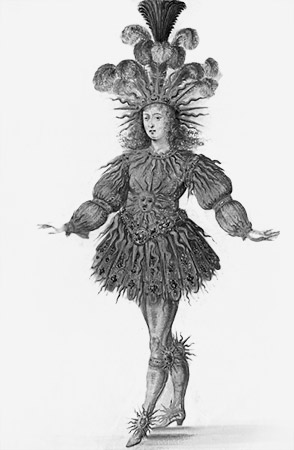
1. Nguồn gốc Lịch sử
Lịch sử của múa ballet có thể truy ngược về thời kỳ Văn Nghệ Phục hưng Ý vào thế kỷ 15. Một trăm năm sau, nghệ thuật ballet bước vào thời kỳ hoàng kim dưới thời trị vì của Vua Louis XIV của nước Pháp. Vua Louis XIV đã đích thân thiết lập một hệ thống hoàn chỉnh cho múa ballet, với rất nhiều yêu cầu và quy phạm cơ bản vẫn còn duy trì cho đến tận ngày nay.
Múa cổ điển Trung Quốc đặt định trên cơ sở lịch sử văn minh 5.000 năm Trung Hoa. Kể từ khi có lịch sử ghi chép cho đến nay, vũ đạo Trung Hoa đã tồn tại trong các điệu múa cung đình, múa dân gian, hý kịch, tạp kỹ và võ thuật, trải qua quá trình tôi luyện của các triều đại và văn hóa, truyền từ đời này sang đời khác, không ngừng phong phú hoàn thiện, đã hình thành nên hệ thống múa cổ điển Trung Quốc ngày nay.
2. Yếu lĩnh cốt lõi
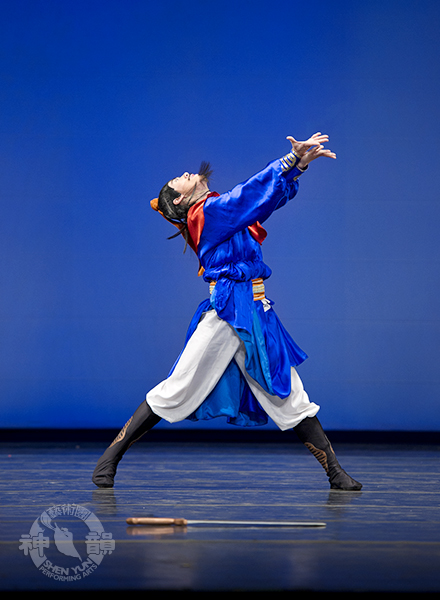
Múa ballet và múa cổ điển Trung Quốc đều có một hệ thống đào tạo hoàn chỉnh riêng biệt, ngoài một mục đích là nâng cao năng lực thể chất của nghệ sĩ múa, trọng điểm và yếu lĩnh cốt lõi của múa ballet và múa cổ điển Trung Quốc đều có điểm khác biệt rất lớn.
Múa ballet chú trọng rèn luyện cơ chân và bàn chân của nghệ sĩ múa hơn, chú trọng vào quy phạm độ chính xác của động tác. Trong khi đó, múa cổ điển Trung Quốc chú trọng vào “thân vận”, “thân pháp”, “kỹ năng kỹ thuật” và tinh thông “diễn xuất”, đòi hỏi các nghệ sĩ múa khi biểu diễn không chỉ làm được động tác chuẩn xác, kỹ thuật cao siêu, mà còn phải bao hàm vận vị ở bên trong vũ đạo.
“Thân vận” là một hình thức biểu đạt độc đáo chỉ có ở múa cổ điển Trung Quốc, mà múa ballet không có. “Thân vận” chú trọng đến “hình, thần, kình, luật”; thông qua ánh mắt, vẻ mặt, hơi thở; đường đi của động tác như “dục tả tiên hữu” (muốn sang trái thì trước hãy sang phải), “dục thượng tiên hạ” (muốn lên thì trước hãy xuống), “viên” (tròn), cho đến xử lý tiết tấu (nhịp điệu) đối với động tác thể hiện ra tính cách, tình cảm phong phú bên trong nhân vật và khí chất đặc thù vốn có của người Trung Quốc. Ví như, vẻ nhu mì kín đáo của nữ nhi, vẻ điềm tĩnh mạnh mẽ của nam nhi v.v. Điểm kỳ diệu của “thân vận” nằm ở chỗ, “thân vận” có mối liên hệ chặt chẽ với cảm xúc tâm thái của nghệ sĩ múa, đặc điểm tính cách của người nghệ sĩ, chuyển biến tình cảm cho đến sự hàm dưỡng văn hóa đều hiển lộ rõ ràng ở trong biểu đạt của thân vận.
Kỳ thực, “thân vận” của múa cổ điển Trung Quốc chính là thể hiện cụ thể của vận vị động tác, hình thức dáng điệu có mang tính dân tộc “mỹ” và “hòa” ở trong đó, cùng với nội hàm văn hóa sâu sắc dung nhập vào tận trong huyết mạch và tế bào của người Trung Quốc dựa trên nền tảng đặt định văn hóa 5.000 năm. Hơn nữa, văn hóa Trung Hoa là nửa-Thần nửa-nhân, là nền văn hóa “thiên nhân hợp nhất”. Điều này không hề đơn giản chút nào. Sau đây chúng tôi sẽ tiến thêm một bước để bàn về nội hàm văn hóa của múa cổ điển Trung Quốc.
3. Rèn luyện tố chất thân thể
Độ dẻo dai và tố chất cơ của các nghệ sĩ múa ballet và múa cổ điển Trung Quốc đều đòi hỏi trải qua một quá trình tôi luyện nghiêm khắc, nhờ đó thể hình của các nghệ sĩ này đều rất mảnh mai. Mặc dù thể hình của các nghệ sĩ múa có nét tương đồng, nhưng phương pháp đào tạo của hai loại hình vũ đạo này lại hoàn toàn khác biệt.
Trong quá trình đào tạo kỹ thuật cơ bản, múa ballet yêu cầu hai chân tạo thành hình chữ “nhất”, đầu gối thẳng hướng ra bên ngoài, phần cơ chân luyện tập bằng phương pháp này là phần cơ rất ít khi sử dụng trong cuộc sống hằng ngày. Ngược lại, múa cổ điển Trung Quốc sử dụng các cơ tự nhiên, luyện tập phần cơ thường hay sử dụng trong những hoạt động hằng ngày như đi bộ, chạy bộ và chơi bóng rổ, phần cơ càng tự nhiên thì năng lực càng lớn, điều này không những giúp giảm bớt gánh nặng cho luyện tập kỹ thuật cơ bản, mà còn giúp cho các nghệ sĩ múa có thể hoàn thành những kỹ thuật nhào lộn với độ khó cao của múa cổ điển Trung Quốc một cách an toàn hơn.
4. Kỹ năng kỹ thuật
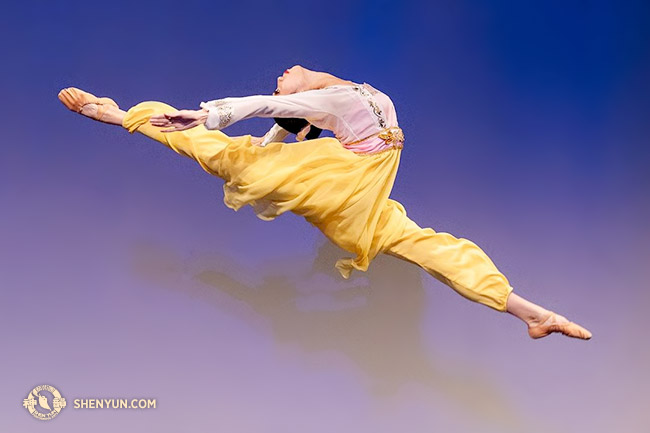
Trong kỹ thuật của múa ballet có xoay tròn, nhảy cao, nâng đỡ v.v. Trong khi đó, kỹ thuật của múa cổ điển Trung Quốc có phạm vi rất rộng, chủ yếu có thể phân thành nhảy, xoay, lật và kiểm soát thăng bằng.
Tư thế xoay thân trên của múa ballet khá đơn nhất, thông thường là tư thế tạo thành một góc thẳng với thân dưới. Tuy nhiên, tư thế xoay của múa cổ điển Trung Quốc vô cùng phong phú, thân trên kết hợp với các động tác như ninh (xoắn), khuynh (nghiêng), nâng người v.v. để hình thành những tư thế và chuyển động xoay tuyệt mỹ, ngoài ra còn có thể xoay người với những tư thế đòi hỏi mức độ kiểm soát thăng bằng cao như động tác 紫金冠 (zi-jin-guan) chẳng hạn, những kỹ thuật xoay người này của múa cổ điển rất khó nắm bắt trọng tâm và cân bằng, vậy nên yêu cầu độ khó cao hơn.
Động tác 翻身 (fan-shen) của múa cổ điển Trung Quốc không có trong múa ballet, động tác này lấy phần eo và hông làm trụ, nghiêng người song song mặt đất và xoay, từ đầu đến cuối động tác quán xuyến các tư thế ninh (xoắn), ngưỡng (ngước lên), phủ (cúi xuống) và nâng người, khi nghệ sĩ múa khoác lên bộ trang phục truyền thống với ống tay áo dài rộng thực hiện động tác 翻身 (fan-shen) liên tục, trên sân khấu trông họ như những đóa hoa đang nở rộ với vẻ đẹp kiều diễm, mang đến cho khán giả hiệu ứng thị giác phi phàm.
Những động tác nhào lộn trên không của múa cổ điển thường khiến khán giả phải trầm trồ khen ngợi. Trong vài thập niên gần đây, giới thể thao Trung Quốc đã mượn dùng những kỹ thuật có độ khó cao này trong múa cổ điển, và đưa vào thi đấu Thế vận hội, do vậy [khán giả] trên thế giới thường hay cho rằng những kỹ thuật này có nguồn gốc từ thể thao hoặc tạp kỹ, nhưng kỳ thực chúng bắt nguồn từ múa cổ điển Trung Quốc đã có lịch sử hàng nghìn năm.
5. Mối liên hệ với võ thuật
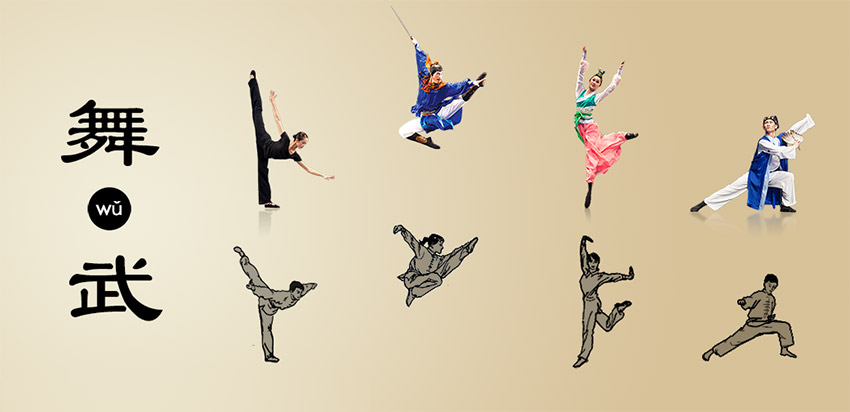
Nhiều động tác kỹ thuật trong múa cổ điển Trung Quốc trông rất giống với động tác võ thuật, vào thời cổ đại, vũ đạo phân thành “văn vũ” và “võ vũ”: dùng văn, thì là vũ đạo cung đình trong cách dịp khánh lễ và đại yến; dùng võ, thì là võ thuật lúc đối đầu với kẻ địch ngoài chiến trường. Vào thời Đường, điệu múa “Tần Vương phá trận nhạc” chính là một ví dụ điển hình về “võ vũ”, đương thời đây là một vũ đạo bày binh bố trận trên quy mô lớn danh tiếng truyền xa đến tận Nhật Bản và Tây Á, có rất nhiều động tác trong đó là thân pháp võ công.
Vũ đạo và võ thuật có rất nhiều động tác thân pháp giống nhau, chẳng hạn như động tác “後空翻” (hou-kong-fan) trong kỹ thuật múa cổ điển, thì trong võ thuật có thể là động tác để tránh cây thương của kẻ địch; động tác “掃堂腿” (sao-tang-tui), trong võ thuật là để tấn công phần thân dưới của nhiều kẻ địch cùng một lúc; động tác “踹燕” (chuai-yan), trong võ thuật là để tấn công vào mặt của kẻ địch đồng thời ngửa về sau để tránh vũ khí của kẻ địch. Những động tác giống với võ thuật này, trong múa cổ điển, đã dung nhập thêm thân vận và diễn xuất, chú trọng thiên về [giá trị] thẩm mỹ và quá trình triển hiện động tác của thân thể, cho nên càng mềm mại, chậm rãi và kéo dài hơn.
武 (võ) và 舞 (vũ) có cùng một nguồn gốc, nhất vũ (võ) lưỡng dũng, đồng âm nhưng khác chữ, một âm một dương, một văn một võ, cũng chính là thể hiện nét đặc sắc của văn hóa Thần truyền Trung Hoa. Ngoài ra, tính chất đặc thù phòng thân hộ mệnh của võ thuật, cũng có tác dụng bảo đảm cho rất nhiều thân pháp và kỹ thuật của múa cổ điển Trung Quốc trải qua hàng nghìn năm lưu truyền cho đến ngày nay không bị biến đổi, và tỏa sáng rực rỡ trên sân khấu nghệ thuật thế giới hôm nay.
6. Nội hàm văn hóa
Sự khác biệt về bản chất giữa múa ballet của phương Tây và múa cổ điển Trung Quốc của phương Đông nằm ở sự khác biệt giữa hai nền văn hóa này.
Múa ballet đã từng rất phổ biến vào thời kỳ Văn nghệ Phục hưng Ý và giữa các quý tộc trong triều đình dưới thời trị vì của Vua Louis XIV của nước Pháp, đây là một môn nghệ thuật tao nhã và nghiêm khắc, tiết tấu vũ đạo của múa ballet tương đối bình ổn và có quy luật, động tác vũ đạo tuân theo các chuẩn mực “khai, băng, trực, lập”, về tạo hình động tác chủ yếu lấy đường thẳng và góc độ [chính xác] nghiêm ngặt để làm khung sườn cơ bản, chú trọng cảm giác cân bằng và đối xứng của thân thể, làm toát lên khí chất cao quý nho nhã quý tộc và cá tính độc lập hướng ngoại của người Tây phương.
Múa cổ điển Trung Quốc kỳ thực là một bộ phận của văn hóa Thần truyền 5.000 năm. Múa cổ điển không chỉ mang vẻ đẹp huy hoàng lộng lẫy của vũ đạo cung đình, muôn màu muôn vẻ của vũ đạo dân gian, ngoài ra còn bao hàm những nét văn hóa đặc sắc của mỗi triều đại và nội hàm tinh thâm cấu thành từ nền tảng tín ngưỡng Nho gia, Phật gia và Đạo gia xuyên suốt trong đó. Tạo hình động tác của múa cổ điển thường lấy “viên” (tròn) để làm đơn vị cơ bản. “Viên” có thể triển hiện xuất ra “thiên nhân hợp nhất” trong tư tưởng Đạo gia, “viên dung” trong tư tưởng Phật gia và lý niệm “trung dung” của Nho gia, giữa hai động tác lấy “viên” làm lộ tuyến kết nối, có thể khiến cho động tác biểu lộ ra sự trôi chảy liền mạch giống như nước chảy mây trôi.
Bên cạnh đó, đặc điểm phát lực và vận luật của múa cổ điển Trung Quốc là: “dục tả thiên hữu” (muốn sang trái thì trước hãy sang phải), “dục tiền tiên hậu” (muốn lui thì trước hãy tiến), “dục thượng tiên hạ” (muốn lên thì trước hãy xuống), “dục hạ tiên thượng” (muốn xuống thì trước hãy lên), muốn triển hiện ra ngoài thì trước hãy dưỡng dục bên trong, chú trọng một quá trình tu dưỡng, ngẫu nhiên mà phù hợp với quy luật vạn sự vạn vật tương sinh tương khắc và sinh sôi không ngừng nghỉ trong văn hóa Trung Hoa.
Văn hóa phương Tây chú trọng hơn về ngoại hình chuẩn xác và kỹ thuật tinh tế, còn văn hóa Trung Quốc chú trọng hơn về phần “Thần”. Trong thân vận của múa cổ điển Trung Quốc, yêu cầu vận dụng phối hợp “thân, nhãn, thủ, pháp, bộ”; còn các tư thế “ninh (xoắn), khuynh (nghiêng), viên (tròn), khúc (uốn khúc)” trong động tác vũ đạo, là để biểu đạt tinh tế những thay đổi cảm xúc, nội hàm và vẻ đẹp nội tại, ví dụ trong một động tác xoắn người của nữ nghệ sĩ, có thể biểu hiện ra nhiều tâm thái như hàm súc, e lệ, không nỡ v.v. “Dĩ thần ngự hình” (lấy thần chế ngự hình thể), “hình thần kiêm bị” (đồng thời có cả hình thể và thần thái) là đặc điểm chủ yếu của múa cổ điển Trung Quốc, cũng là một trong những lý do vì sao múa cổ điển Trung Quốc có sức biểu cảm phong phú.
Văn hóa Trung Quốc là nền văn hóa tiếp cận với Thần, vào thời Trung Quốc cổ đại, các ngành các nghề đều gọi là “Đạo”, học tập một kỹ nghệ có thể gọi là “tu luyện” kỹ nghệ này, chú trọng tu dưỡng cả đạo đức và kỹ năng, cho rằng cảnh giới đạo đức của cá nhân là nhân tố quyết định trí huệ và kỹ năng của người đó. Nghệ sĩ múa trong quá trình tu tập bản thân, cùng lúc biểu lộ ra vẻ đẹp tự nhiên phù hợp với giá trị thẩm mỹ phổ quát. Nghệ sĩ múa cổ điển trong lúc học tập văn hóa truyền thống, đề cao tâm tính và chuẩn mực đạo đức, đồng thời khắc khổ rèn luyện kỹ thuật vũ đạo, khiến cho thân và tâm của người nghệ sĩ đều có thể thăng hoa lên trên. Điều này khác biệt hẳn so với các hoạt động thể thao và vũ đạo thông thường.
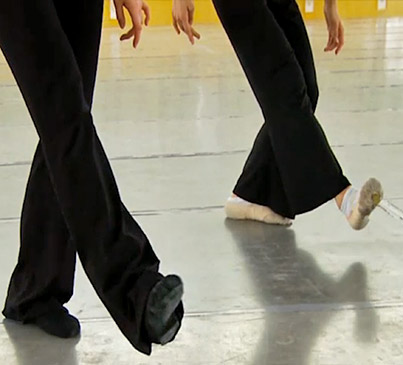
7. Động tác chân
Trên sân khấu, chúng ta có thể dễ dàng nhận ra điểm khác biệt giữa múa ballet và múa cổ điển Trung Quốc chính là hình dáng bàn chân của nghệ sĩ múa. Nữ nghệ sĩ múa ballet thường di chuyển bằng mũi chân thẳng, hai chân co duỗi ở trạng thái thẳng tắp. Trong khi đó, nữ nghệ sĩ múa cổ điển Trung Quốc thường di chuyển bằng bước “viên trường”, lúc cất bước “viên trường”, gót chân chạm đất trước, sau đó mới đến lòng bàn chân, gan bàn chân, dáng bàn chân hơi hơi cong giống như chiếc thuyền. Hai chân hơi chùn, không căng cứng, như vậy lúc rảo bước nhanh sẽ khá nhẹ nhàng. Trong quá trình đào tạo, mỗi bước “viên trường” thường có khoảng cách từ gót chân cho đến mũi chân, do vậy lúc ở trên sân khấu, bước đi của nghệ sĩ múa rất uyển chuyển nhẹ nhàng, phảng phất hình bóng “liên bộ khinh di” (dáng đi thướt tha) của thiếu nữ thanh tú thời xưa. Bước “viên trường” mượt mà liền mạch, cũng khiến cho nghệ sĩ múa trông như đang trôi bồng bềnh trên mây.
Ngoài bước “viên trường”, múa cổ điển Trung Quốc còn có những tư thế khác như “câu”, “băng” và “khối”, các tư thế này giống như hình dạng bàn tay khác nhau của múa cổ điển, đều có thể truyền đạt ngôn ngữ vũ đạo khá phong phú.
Kho tàng văn hóa quý báu chia sẻ với toàn thế giới
Nghệ thuật vũ đạo là loại hình ngôn ngữ mà các dân tộc trên toàn thế giới đều có thể lĩnh hội, nghệ thuật chính thống sẽ đánh thức sự theo đuổi những điều tốt đẹp và thiện lương của con người, đồng thời có thể mang lại ảnh hưởng chính diện và sự thăng hoa mạnh mẽ cho văn hóa nhân loại, nghệ thuật ballet đã chứng minh điểm này, và múa cổ điển Trung Quốc còn tinh tế phong phú hơn, sẽ khai sáng một chương mới cho nền nghệ thuật của nhân loại, để trở thành một bảo tàng nghệ thuật chia sẻ với các dân tộc trên toàn thế giới.
Đọc hàng nghìn quyển sách cũng không bằng đích thân trải nghiệm. Chúng tôi chân thành mời quý khán giả đến thưởng thức biểu diễn Shen Yun, để có thể một lần cảm nhận múa cổ điển Trung Quốc thuần chính.


